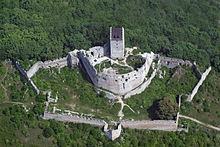Inner bailey


Theinner baileyorinner wardof a castle is the strongly fortified enclosure at the heart of amedievalcastle.[1]It is protected by theouter wardand, sometimes also aZwinger,moats,acurtain walland other outworks. Depending on topography it may also be called anupper baileyorupper ward.
The inner bailey enclosed the most important living quarters and defensive elements for the lord and his family, e.g. thegreat hall,thepalas,thetower houseand thekeeporbergfried.Thecastle wellorcisternwas usually found in the inner bailey, because water supplies were particularly important in the past in order to be able to withstand asiegefor any length of time.
The inner bailey is usually the oldest part of a castle, because it contains those buildings that were the first to be built during its construction. It often hasflanking towersthat enabled grazing fire to be brought to bear in front of thecurtain walland gave additional protection to the castlegate.
In complex castles the buildings of the inner ward were frequently grouped in a ring around a courtyard which acted as a central storage area and – if it were large enough – as a tournament arena.

The terms "upper bailey" or "upper ward" are sometimes used to describe the inner bailey of ahill castleorwater castlewhere the main ward was usually higher than the outer or "lower" bailey. Similarly theRomanesqueinner ward ofHohensalzburg Fortressis still called theHoher Stock( "Upper Storey" ).
See also
[edit]References
[edit]- ^Friar, Stephen (2003).The Sutton Companion to Castles,Sutton Publishing, Stroud, 2003, p. 22.ISBN978-0-7509-3994-2
Literature
[edit]- Horst Wolfgang Böhme, Reinhard Friedrich,Barbara Schock-Werner(ed.):Wörterbuch der Burgen, Schlösser und Festungen.Philipp Reclam, Stuttgart, 2004,ISBN3-15-010547-1,p. 169.
